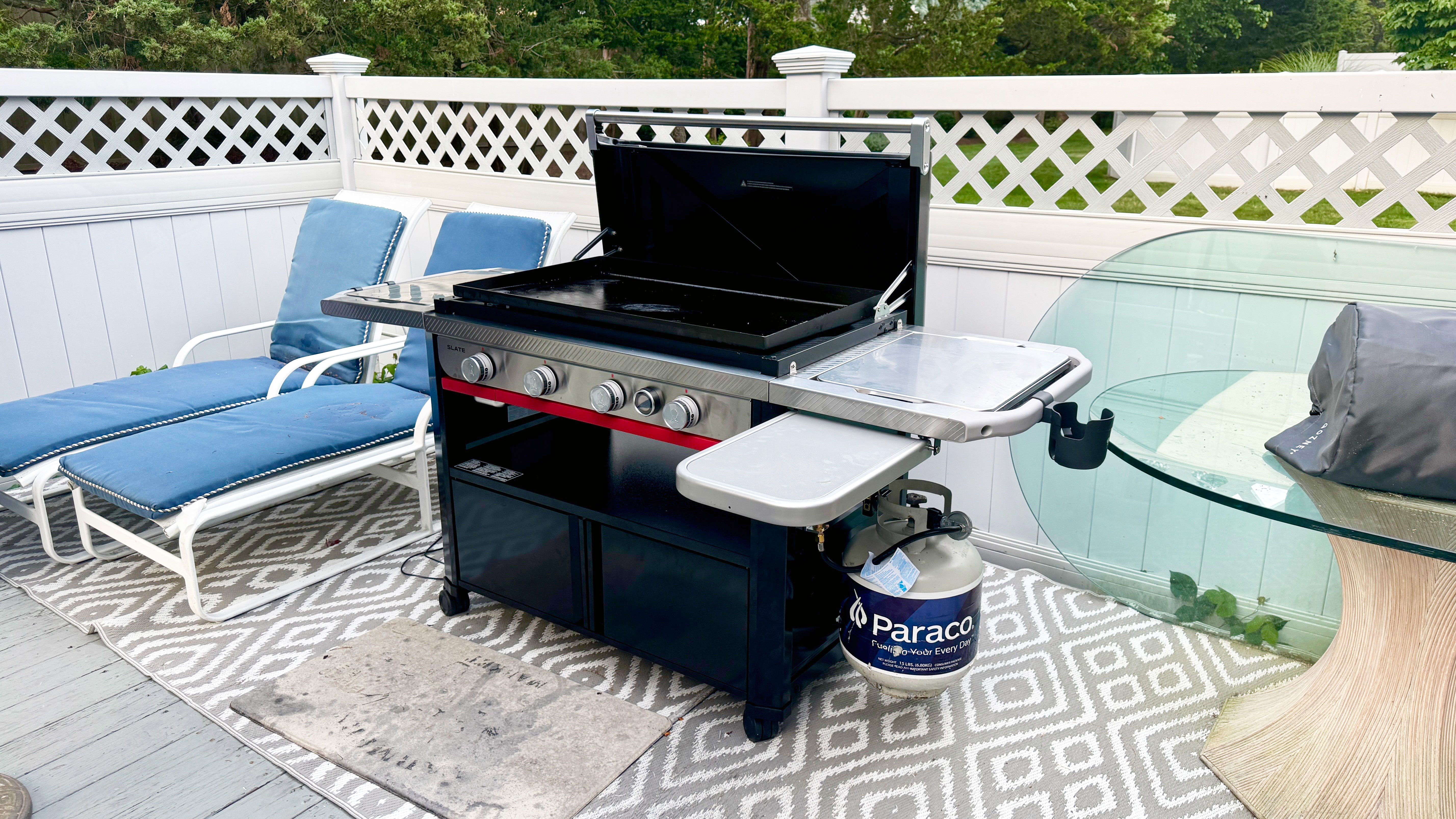
The flat-top griddle phenomenon isn’t ending anytime soon — in fact, the Weber Slate 36 griddle might be impressive enough to convince people to ditch their traditional grills for good. With a massive 36-inch cooktop, built-in storage, collapsible shelves, digital thermometer, sturdy grease trap, clever accessories and more, the Slate offers pretty much everything you could want from a home griddle.
But the *real* kicker? The Weber Slate 36’s rust-resistant cooktop comes pre-seasoned. Yes, that means you don’t have to spend an hour-plus doing the song and dance of getting your griddle ready for its first cook. As long as you follow proper maintenance techniques, you’ll spend far less time cleaning and more time enjoying your cheesesteaks and smashburgers. At least, that’s been my experience in the month I’ve had this Weber griddle.
At $999, the Weber Slate 36 is far from the most affordable appliance to kickstart your griddle cooking journey. That said, if you’re interested in a fun and user-friendly way to feed your family, it’s easy to recommend. It’s excellent for beginners but will especially impress griddle enthusiasts like myself. You can read my entire Weber Slate 36 review below to find out the biggest reasons I think this is one of the best grills money can buy.
Weber Slate 36 griddle cheat sheet
- Who is the Weber Slate 36 for? The Weber Slate 36 is suited for both first-time griddle users and people looking to upgrade their existing griddles. It takes about an hour to set up and with the pre-seasoned griddle, it’s practically ready to use out the box.
- What is the Weber Slate 36 price? The Weber Slate 36 costs $999. Weber also sells a 30-inch version with three burners that costs $799 with 540 sq. inches of cooking space compared to the 756 sq. inches of cooking space across four burners on the Slate 36.
- Is the Weber Slate really rust resistant? The Weber Slate 36 claims to be rust-resistant, but if you don’t properly clean your griddle between cooks, the coating can deteriorate and you may need to re-season the carbon steel cooktop. Weber also offers a 5-year warranty for the Slate 36 and Slate 30, though it doesn’t cover rusting.
- Are Weber Slate accessories included? The Weber Slate 36 is compatible with a large collection of accessories at additional fees. Some include the Griddle Essentials Set ($59), Weber Works Caddy with Tray Lid ($39), and the Weber Works Organizer Kit ($49) that comes with a paper towel holder and garbage bag holder.
- Does the Weber Slate come with a cover? The Weber Slate 36 does not come with a cover. One can be purchased separately for $109.
- Weber Slate vs. Blackstone? Blackstone is a bit better known for its griddles, and you can get a Blackstone model for much less than the Weber Slate. Most Blackstone units can also hook up directly to a natural gas line, while the Slate 36 cannot (only the 30-inch Slate has a natural gas model.) That said, the Weber Slate build quality is hard to beat and no Blackstone units come truly pre-seasoned like this Slate.
Weber Slate 36 griddle specs
Weber Slate 36 review: The ups
Griddle comes pre-seasoned
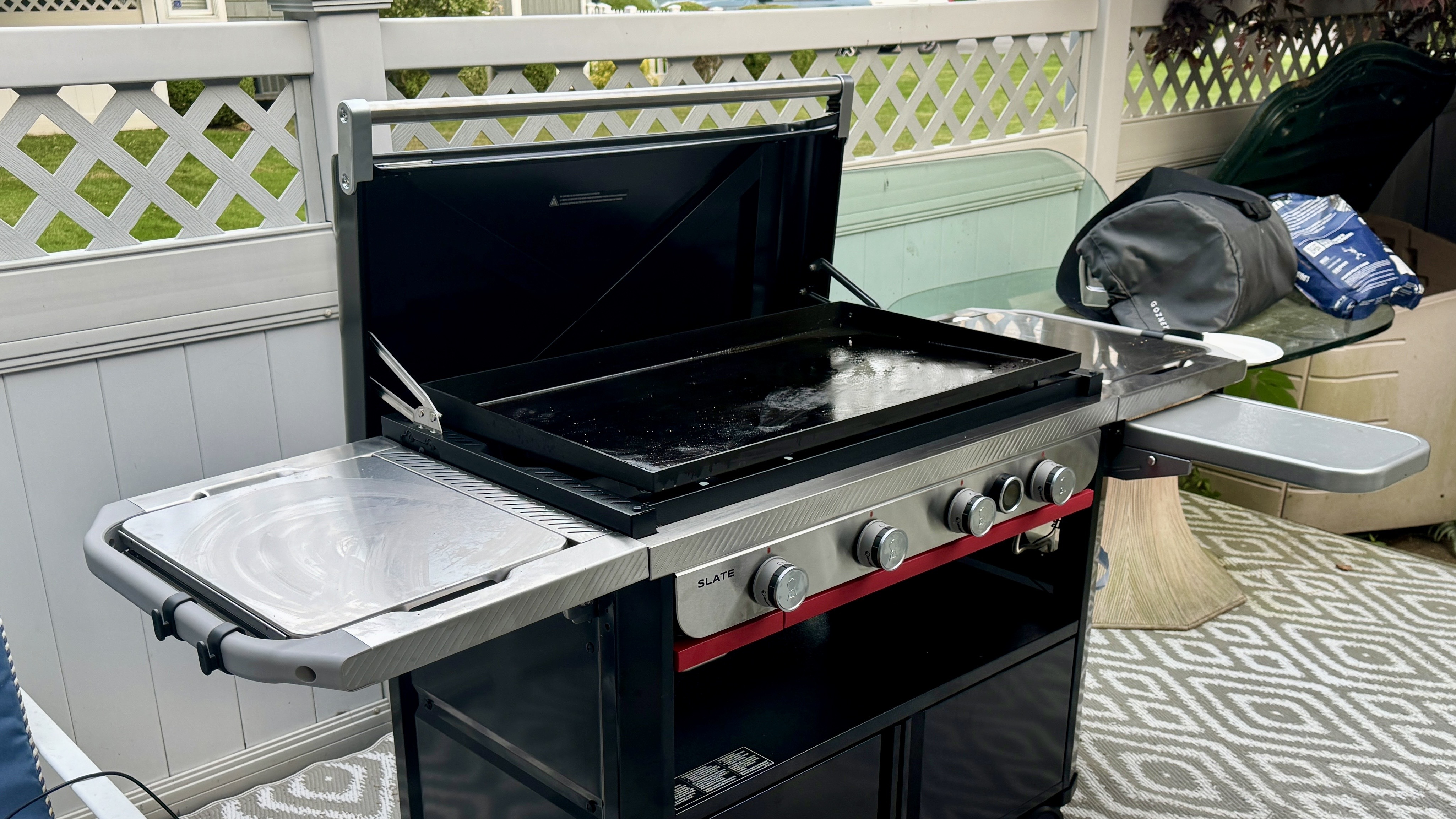
The biggest selling point of the Weber Slate 36 is that carbon steel griddle comes pre-seasoned. This was a first for me — every other griddle I’ve tested included the $999 Traeger Flatrock required a multi-step seasoning process in which you burn off neutral oil repeatedly until the surface turns from silver to black. It can take nearly an hour and an entire roll of paper towels to complete. But with the Weber Slate 36, the cooktop comes ready to cook on… well, almost. I recommend giving it a quick wipe with warm water and dish soap to clean up any grime accumulated from the production line. After that, soap stays far away from the cooktop.
I oiled the griddle down with a neutral oil (avocado oil is my personal preference) and let it heat it up for about 20 minutes before attempting my first cook. I did notice some discoloration appear directly over where the burners sit, but this is normal for a new griddle. After breaking it in with a dozen or so cooks, the cooktop adopted a mostly uniform finish. This, of course, included regularly cleaning between cooks, scraping food crumbs into the grease trap and using some water to lift those few stubborn burnt bits. Then, as the griddle cooled down, I let it marinate with a fresh thin layer of oil so it was ready for the next use.
Extra shelving and storage
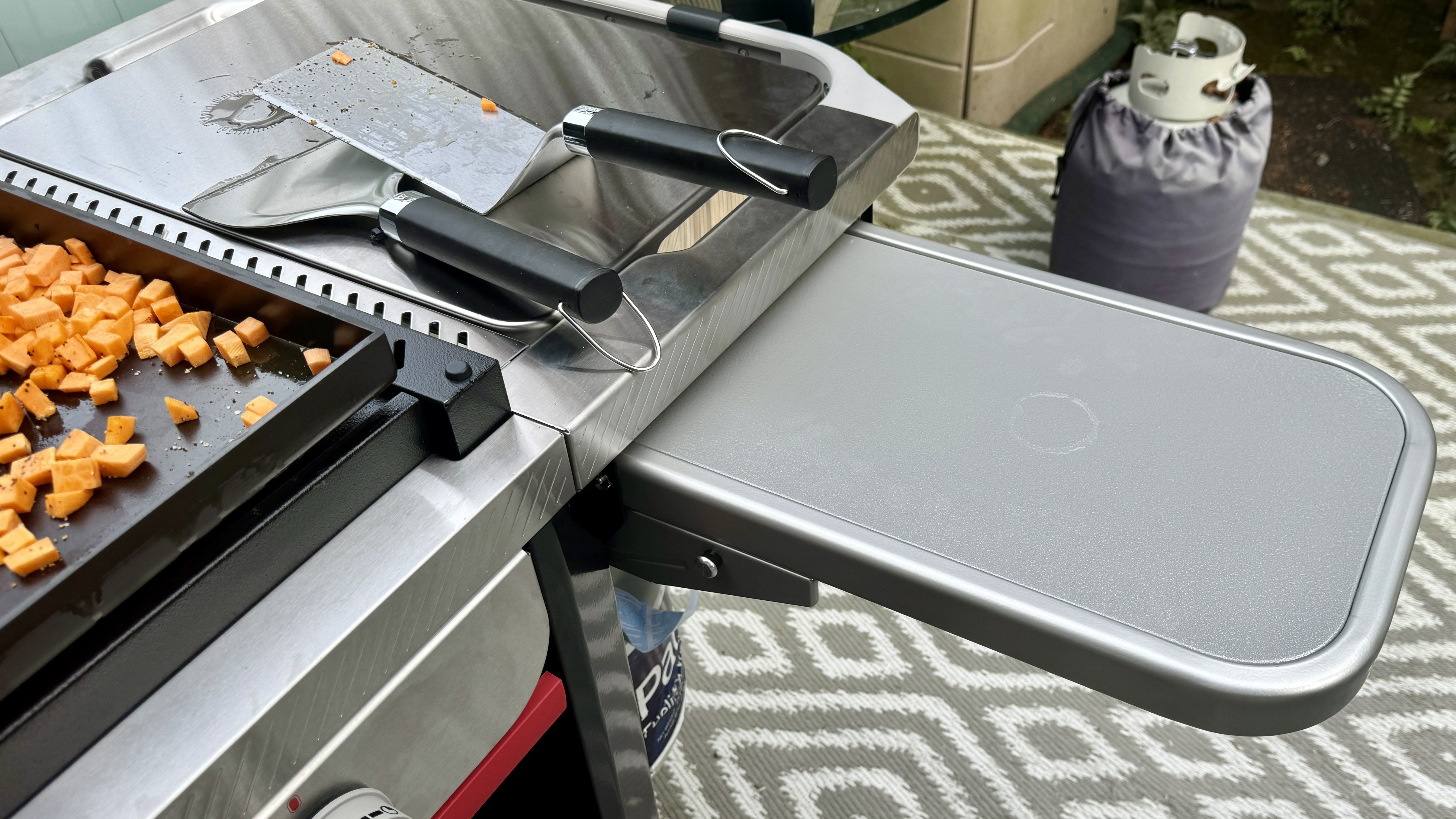
Cooking with griddles is fun, but it usually requires a collection of tools and accessories. I’ve acquired countless spatulas over the years, yet I’ve never managed to find a smart way to keep them organized and accessible when I need them. The Weber Slate 36 fixed that problem with cabinet storage and a shelf beneath the grill. Instead of buying the Weber Works Caddy, I kept a small spare storage bin in the cabinet with all my griddle gear at the ready. I used the shelf to hold extra serving trays as I cooked, so I never needed to stray away from the grill.
What’s more, in addition to two shelves on either side of the grill, the right shelf comes with a perpendicular flip-up extension. This gave me more precious space while prepping food for the griddle, and doubled as a convenient place to keep my mandatory grilling drink. I appreciated not having to struggle for room, especially when putting together big meals for my family and friends.
Even heating and cooking
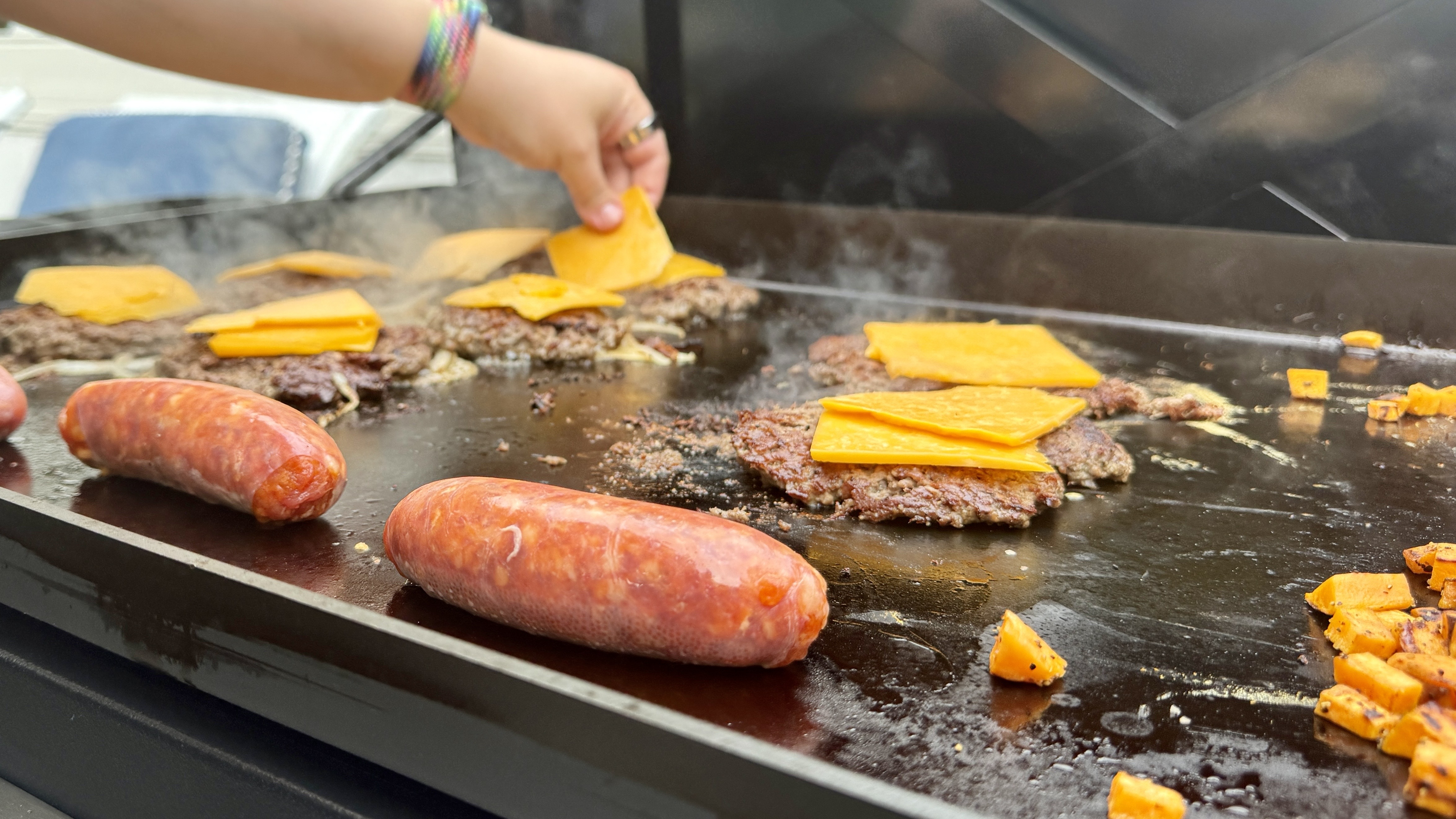
So, how does the Weber Slate 36 do when it actually comes to cooking? It features 4 adjustable burners that can reach over 500 degrees, though I found ~350 degrees is the sweet spot for griddle cooking, and it’s usually best to let the grill heat up uniformly on a low setting if you’re cooking many items. As checked with my trusty digital thermometer, the cooking area heated up mostly evenly, with the center right panel running a little hotter than the rest of the grill. But almost every grill has a hot spot, which is worth keeping in mind as you plan out where you place your food.
The most typical griddle foods in my household include smashburgers, cheesesteaks, bacon, eggs and pancakes. I pressed down the burgers in the center of the grill, but toasted the buns off the side just above the grease trap to prevent them from burning. Same goes for breakfast — bacon in the hot spot and eggs, which cook in approximately 60 seconds on a griddle, on the side. That said, I found the griddle was extremely forgiving, so you don’t have to worry about where exactly you place down your food every time. The oily nonstick surface lets you move food around easily while still achieving a satisfying cook. You might not get grill lines, but you do get crispy edges and an even finish on your food.
Massive cooking space
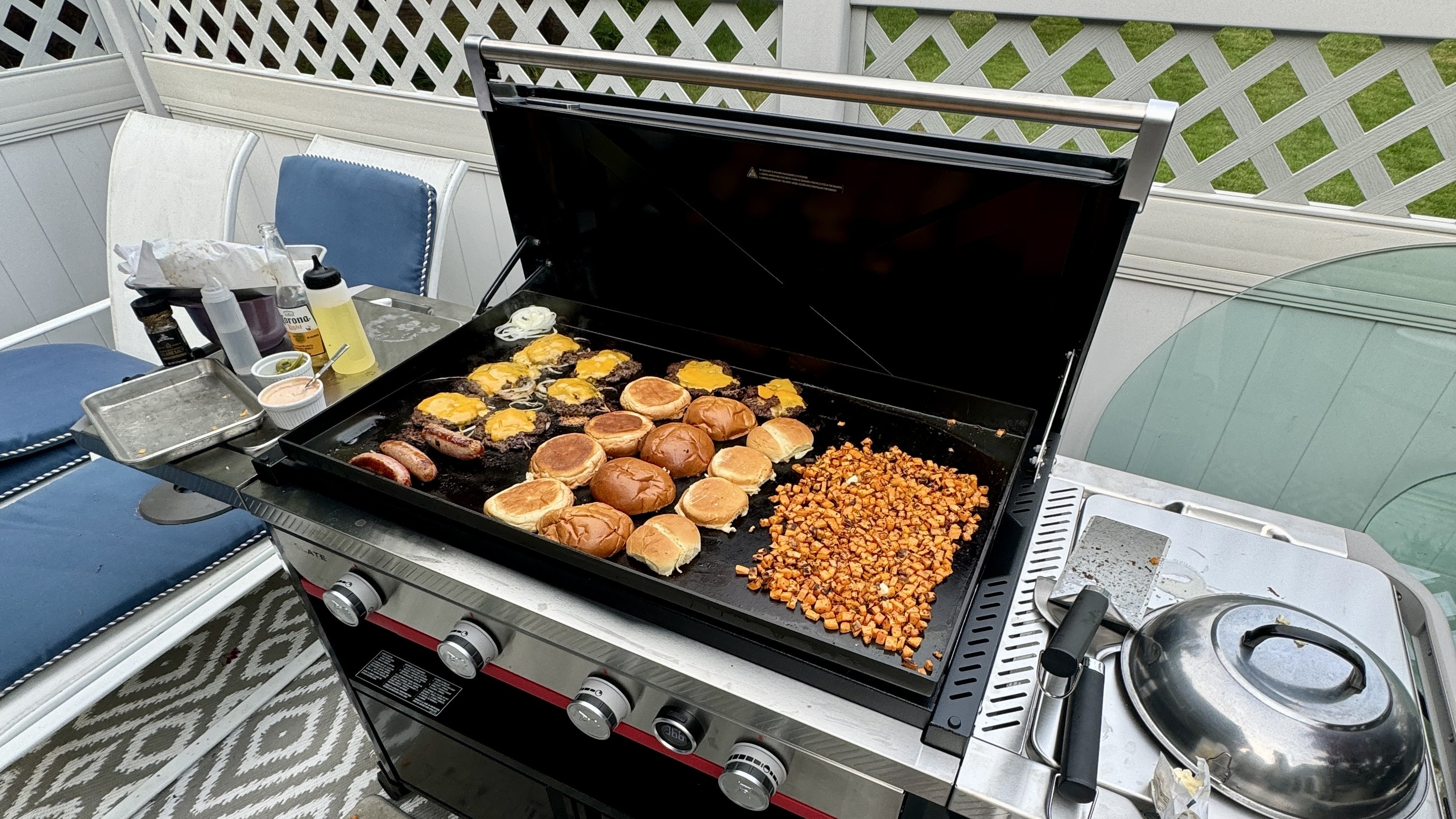
If you have a lot of mouths of feed, the Weber Slate 36 is an excellent option. The cooking area measures 36.35 x 21.35 inches, giving plenty of space to work with. I’m usually feeding at least four people, but I often volunteer to host our neighbors for dinner, so I couldn’t imagine going back to a smaller griddle as my primary outdoor appliance. With more space, you can simultaneously prepare everything you need for a meal. For me, this meant caramelizing onions, toasting buns, smashing burgers, searing diced potatoes and cooking pieces of bacon all at once.
The griddle’s size is really what justifies its price tag. You can spend less on a smaller griddle, but may need to be more strategic in how you space and pace your cooking. The Slate 36 gave me the kind of flexibility I wish I had when I first started using griddles a few years ago.
Weber Slate 36 review: The downs
Inaccurate digital thermometer
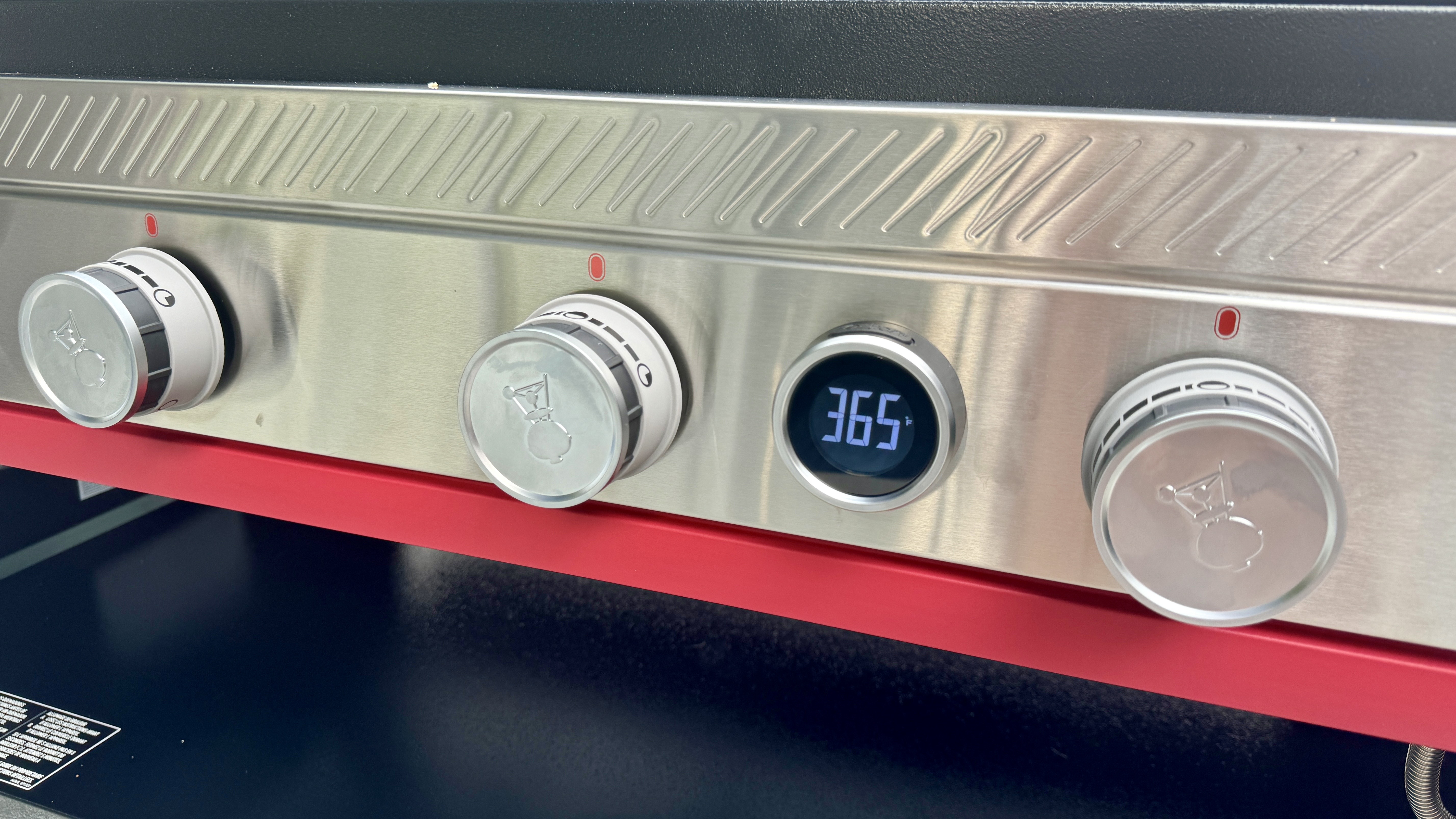
There’s very few negatives I can point out about the Weber Slate 36. The only thing I sorta struggled with is the digital thermometer display on the front of the unit, located between the temperature knobs. This display is meant to take the guesswork out of knowing the griddle’s temperature, and while it does give an OK sense of whether the surface is hot or not, it’s not very accurate. It regularly reads 20-30 degrees less than the surface temperature registered with my handheld digital thermometer.
Perhaps keeping my griddle in the sun causes the thermometer to struggle, but I’ve pretty much bypassed using it instead relying on my griddle experience to know if my cooktop is hot enough. I do recommend picking up a digital infrared thermometer if you don’t have one already, it’s a versatile tool that I’m sure you’ll find more uses for in your home than you’d expect. I like this $30 ThermaPro one from Amazon.
Weber Slate 36 review: Verdict
The Weber Slate 36 sets a new standard for large griddles and flat-top grills. It’s easy to use and obviously designed with all experience levels in mind. While I wish the integrated thermometer worked better, it’s definitely not a deal-breaker. I can’t lament about the add-on fees for accessories and the cover either, since that’s pretty standard in the grilling market.
What’s not standard is a pre-seasoned cooktop that’s practically ready to use out of the box. If you ask me, it makes griddle cooking less intimidating, even more so for beginners. It’s certainly an investment for a first-time griddle, but one that’s worth it in terms of convenience and quality.







